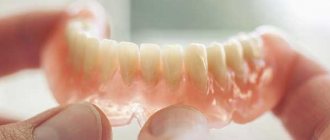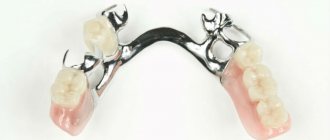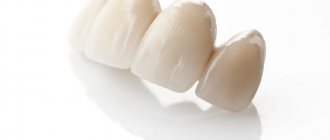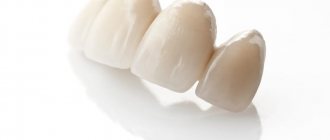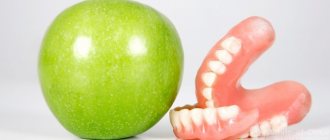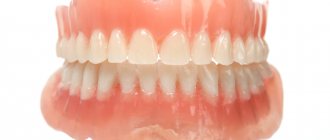Clasp dentures can be used to restore defects in the dentition when several consecutive teeth are lost. This application provides a metal base, which provides the necessary strength to the prosthetic structure. Clasps are also successfully used for splinting teeth. After installation, the prosthesis holds the moving teeth together and prevents them from loosening even more. Splinting with clasp dentures allows you to stop the process of tooth loss due to periodontal diseases and inflammatory processes. The prosthesis is fixed to the supporting teeth, so this type of prosthetics is not suitable for the treatment of complete edentia.
Construction of a clasp prosthesis
The basis of the prosthesis is a clasp made of metal. An acrylic imitation of gums and artificial teeth are formed on a metal arch. For fastening, metal hooks are used that hook onto the supporting teeth.
Since the design of the clasp prosthesis contains metal elements, it cannot be fixed directly to the gum. As a result, a tight fit cannot be achieved. To install the prosthesis, support is required on both sides. Usually, your own teeth are used as support, but it can also be an implant with a crown installed.
Indications and contraindications
Installation of beam prostheses is indicated for:
- existing extensive defects: loss of several teeth (4–5);
- defects in the lateral part of the dentition, combined with minor defects in the terminal and anterior parts;
- the presence of defects in the end and side sections of the row;
- the need to splint abutment teeth by connecting them into one structure with a beam and artificial crowns;
- treatment of periodontal diseases with complications in the form of partial tooth loss.
Contraindications include:
– insufficient height of the supporting teeth, which does not allow reliable fixation of artificial crowns;
– a small gap between the toothless alveolar processes or the process and the antagonist tooth;
– fragile fixation in the absence of 1-2 teeth: support-retaining clasps are required to strengthen the structure.
Contraindications
- The patient has an allergy to metals. In this case, you need to choose metal-free prostheses for treatment.
- Complete or marginal edentia. Since two supports are required to secure the prosthesis, they cannot be used if the patient is completely edentulous. It is also impossible to fix the clasp arch even if the last molars are missing, since the support will only be on one side.
- Treatment of adentia in the smile area. Clasp dentures are not aesthetically pleasing and are noticeable against the background of your own teeth. It is better not to place them in the smile area.
Description of the prosthesis
The basis of the prosthesis is a strong metal arch, which is responsible for uniformly distributing the load on the jaw when chewing food.
Thanks to this, the supporting teeth are not subject to rapid wear. One of the main advantages of the design is increased comfort and maximum aesthetic effect. The prosthesis is small in size, the patient does not feel its presence in the oral cavity, and also, others will not notice it. In addition, there is no distortion of taste sensations.
A clasp removable denture can be installed if there are abutment teeth on which the structure is attached. Otherwise, the patient may be recommended to have implants installed.
Clasp dentures are classified according to the method of their fixation. The fastening system is:
- Zamkova.
- Clasp room.
- Koronkova.
The simplest and most cost-effective option for attaching a clasp prosthesis is fixation with clasps. These are metal hooks that are attached to your own teeth. The indication for this type of fastening is the absence of crowns on the teeth that are located next to the clasp structure. Advantages:
- Reliable fastening.
- Chewing load endurance.
- Affordable price.
The disadvantage of clasp fixation of the structure is the aesthetic side, that is, the metal hook is visible to others if the prosthesis is installed in the smile area.
The second method is to fix the prosthesis using micro-locks. They consist of two parts: the first is mounted in the prosthesis, the second in the metal-ceramic crown. It is attached to the abutment tooth shortly before fixing the clasp denture to the upper or lower jaw. When these two parts are connected, the micro-locks snap into place. If necessary, it opens using a special tool or a characteristic movement.
Clasp prosthesis with locks can be supplemented with other micro-locks (rail, crossbar, spherical, etc.). Locking has many advantages:
- Reliable fastening.
- Installation is allowed even in difficult situations. For example, a serious defect in the supporting tooth.
- Withstands chewing loads.
- No effect on articulation.
- She is not visible to others.
- Long operational period.
The only drawback is the higher cost.
The third type of fixation is coronal. It is also called telescopic. It has a fundamentally different mounting method. A hollow crown is made on the prosthesis, and a smaller crown is placed on the patient’s tooth. Installing a prosthesis involves putting a large crown on a small one, thus fixing it.
Advantages
- Strong fixation. Even with clasps, the base is attached very firmly, the prosthesis lasts a long time. Telescopic crowns provide even more secure fastening. It will not be possible to remove it without the help of a doctor.
- Strong fixation. Even with clasps, the base is attached very firmly, the prosthesis lasts a long time. Telescopic crowns provide even more secure fastening. It will not be possible to remove it without the help of a doctor.
- Splinting abilities. The prosthesis can splint mobile teeth. This allows them to be used in the complex treatment of dental diseases.
- Long service life. On average, a clasp denture lasts about 10 years. With proper care, this period may be longer. Long-term operation is ensured by the strength of the structure and the reliability of its fixation.
Professional services of specialists from the Interdentos clinic
If you want to undergo dental prosthetics, we recommend that you trust the dentists and technicians of our medical center. We employ the best specialists in the field of prosthetics who can cope with tasks of any complexity. Branded equipment and the use of innovative technologies and modern materials allow us to create reliable, durable installations with a guarantee of quality.
When calculating the cost of our work, the following parameters are taken into account:
- A type of prosthesis design.
- Product material.
- Fastening method.
- The degree of complexity of the required actions.
Contact us - we will help you restore the beauty of your smile and your self-confidence! Our competent doctors will do everything possible to make you forget about your dental problems. If you have any questions or want to make an appointment with a specialist, call or email us!
Flaws
- Low aesthetics. Dentures with hooks have the lowest aesthetics, as they are noticeable on the supporting teeth. Prostheses on telescopic crowns are a more expensive option, but they have higher aesthetics.
- Long-term addiction. Despite the fact that clasp dentures are quite comfortable to wear, getting used to them takes a long time. It takes especially long for patients to get used to dentures with clasps, as they feel good in the oral cavity. In addition, hooks can rub the gums, causing discomfort. During the period of habituation, salivation may increase and diction problems may appear. On average, it takes about 2 weeks from the moment of dental prosthetics to complete adaptation.
- Risk of allergies. The base is made of metal; patients with allergies need to install clasp dentures with caution. The doctor must be warned in advance. In this case, the doctor will conduct an allergy test or recommend another method.
Advantages and disadvantages
Clasp dentures are used very often. This is due to the fact that their installation does not require much time, and the procedure itself does not have many contraindications. In addition, after such prosthetics, the patient practically does not feel any discomfort - his diction does not change, he can easily eat all the food he is accustomed to. In the first days after installation of the prosthesis, a slight pressure may be felt, since the presence of a foreign body in the mouth will be unusual. However, within a week all such sensations will pass.
Another advantage of clasp dentures is their durability. It is these structures that are the most durable compared to any other prostheses. This applies to both mechanical effects on them and physical or chemical ones. This type of structure can be worn around the clock; it will remain stably in a given position.
But the main advantage of this type of prosthesis is that it completely preserves the aesthetic appearance of the dentition. During the procedure, the specialist will select the design option that will fully match the color and shape of the patient’s natural teeth. Thus, people around you will not notice the presence of an artificial element in your mouth at all.
As for the disadvantages of clasp dentures, they include the following:
- quite high price, which is compensated by a long period of use;
- mandatory presence of supporting teeth to fix the structure;
- temporary discomfort in the first days after installation, which soon disappears completely.
The last of the minuses is quite insignificant, given that after a few days a person will absolutely not notice the presence of a prosthesis and will be able to lead his usual lifestyle, enjoying his smile.
Alternative methods of dental prosthetics
None of the methods can be considered universal. Clasp dentures have disadvantages and have contraindications. In such situations, the orthopedist will choose another method for you. Our clinic uses different methods. An alternative to clasp dentures can be:
- Acri Free prostheses. They are highly comfortable while wearing. Unlike clasp prosthetics, Akri Free can be used even with complete edentia. Another advantage of these structures is their high aesthetics. It is achieved due to the fact that soft and elastic plastic is used to make the gingival part.
- Acrylic dentures. Such orthopedic structures are distinguished by their low price. Traditional acrylic products are characterized by low strength and service life. We offer dentures made of acrylic with the addition of diamond chips. This design solution allows us to produce strong, durable and aesthetic products.
- On locks or attachments. Suitable if healthy tooth roots are preserved. The prosthesis is attached to its own roots using fixing locks. The service life of such prostheses depends on the condition of the supporting roots.
These methods of dental prosthetics allow you to restore the integrity of the dentition and return the patient to a healthy and beautiful smile. But compared to them, clasp dentures have a serious advantage - a splinting effect. If there is a need to preserve your own teeth, which have already begun to loosen, clasps are the best option.
Removable dental prosthetics has another disadvantage that must be taken into account when choosing a method. None of the removable dentures can provide an even load on the gums. As a result, bone tissue gradually atrophies. To avoid it, it is better to install fixed or conditionally removable dentures on implants. This approach allows us to ensure the physiological functioning of the dental system. Modern implantation methods make it possible to restore the dentition in 3-5 days; there are types of implants that can be implanted even when bone loss has begun.
Features of clasp prosthetics on the upper and lower jaws
The differences between the upper and lower dentures lie in the location of the bridge and retainers. The arch model depends on the topography of the dentition defect, the shape of the palate, the relief of the alveolar process and other factors.
When restoring the upper jaw, the thickness of the bridge should be 0.9-1.2 mm and the width 4-10 mm. In this case, the arc should be located 0.5 mm from the mucosa. In most cases, the upper jaw prosthesis is fixed on the lateral incisors or molars.
The lower jaw prosthesis must be made with an arch that is unevenly spaced from the mucous membrane: at the upper edge it extends by 0.5-0.6 mm, at the lower edge - by at least 1 mm. In this case, the jumper should not come into contact with the underlying tissues and injure the frenulum. In most cases, the structure is attached to the lateral incisors.
Types of installed implants
Clasp products come in different types, and it depends on the material from which the implant is made:
- metal: steel alloys are used;
- metal-ceramic: in addition to metal parts, the prosthesis has ceramic elements;
- plastic: made of acetal material, this significantly reduces the weight of the implant;
- metal-free: made for allergy sufferers.
Products also differ in the type of fixation
